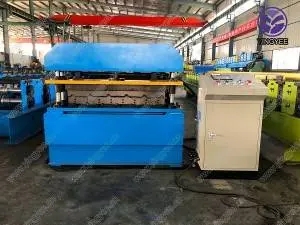
Furring Channel Roll Forming Machine An Essential Tool for Modern Construction
In the ever-evolving world of construction and architecture, the demand for efficient and reliable building materials is paramount. One such material that has gained significant traction is the furring channel, commonly used in wall and ceiling systems to provide a framework for attaching various finishes. This is where the furring channel roll forming machine comes into play, offering a streamlined approach to producing these essential components with precision.
A furring channel is a lightweight metal channel, typically made from galvanized steel or aluminum, that provides support for drywall, plaster, or insulation. It is critical in various construction applications, especially in commercial and industrial projects. The use of furring channels helps create a level surface for attachment, ensuring that the finishing materials are installed securely and uniformly. The production of these channels traditionally involved labor-intensive methods, which often resulted in inconsistencies and waste. However, with the advent of furring channel roll forming machines, the process has become more efficient and cost-effective.
The furring channel roll forming machine is an advanced piece of machinery designed to transform flat metal sheets into shaped furring channels with high accuracy. The process begins with feeding the flat steel coil into the machine. As the coil moves through a series of rollers, it is gradually shaped into the desired channel profile. These machines can be customized to produce various channel sizes and shapes, catering to different construction needs.
One of the key advantages of using a furring channel roll forming machine is the increased efficiency in production. Traditional methods usually involve cutting and welding pieces together, which can be time-consuming and may introduce errors. In contrast, roll forming allows for continuous production, significantly reducing the time from raw material to finished product. This efficiency is not only beneficial for meeting tight project deadlines but also helps to minimize labor costs and material waste.

Moreover, furring channel roll forming machines ensure consistency in product quality. The precise control over the forming process means that each channel produced meets stringent specifications, which is crucial for structural integrity and safety. This reliability fosters confidence among builders and contractors, knowing that they are using materials that meet industry standards.
In addition to efficiency and quality, the versatility of furring channel roll forming machines cannot be overlooked. These machines can be designed to handle varying thicknesses of metal, allowing manufacturers to respond to different market demands easily. Furthermore, they can be integrated with other technologies, such as automated cutting and packing systems, enhancing the overall production line's capability.
As construction trends lean towards sustainable practices, the use of furring channel roll forming machines aligns well with these ideals. The reduction of waste during the production process, coupled with the ability to use recyclable materials, supports environmentally friendly building practices. This is not only beneficial for the planet but also resonates with consumers and investors who increasingly prioritize sustainability.
In conclusion, the furring channel roll forming machine is a vital innovation in the construction industry, driving efficiency, consistency, and sustainability in material production. By automating the process of creating furring channels, manufacturers can deliver high-quality products that meet the growing demands of modern construction projects. As the industry continues to evolve, the role of such machines will undoubtedly become more prominent, shaping the future of building practices. Whether for residential, commercial, or industrial applications, the furring channel roll forming machine stands as a testament to the advancements in manufacturing technology, paving the way for a more efficient and sustainable construction landscape.